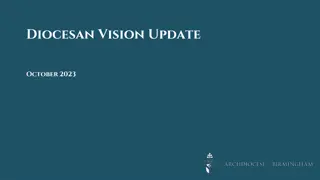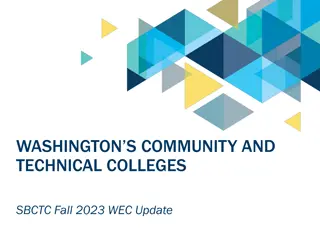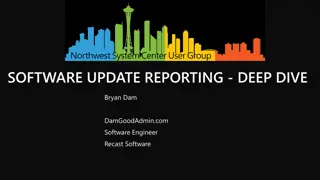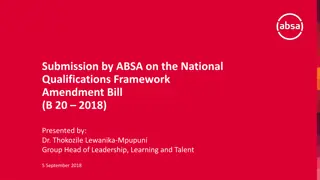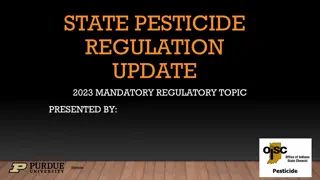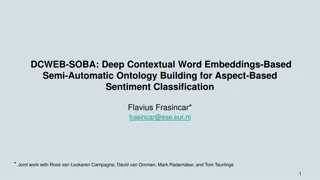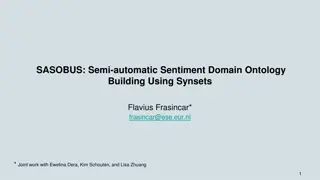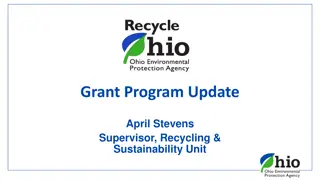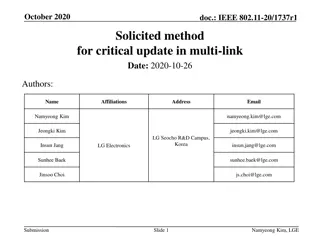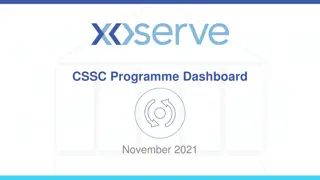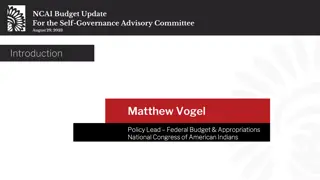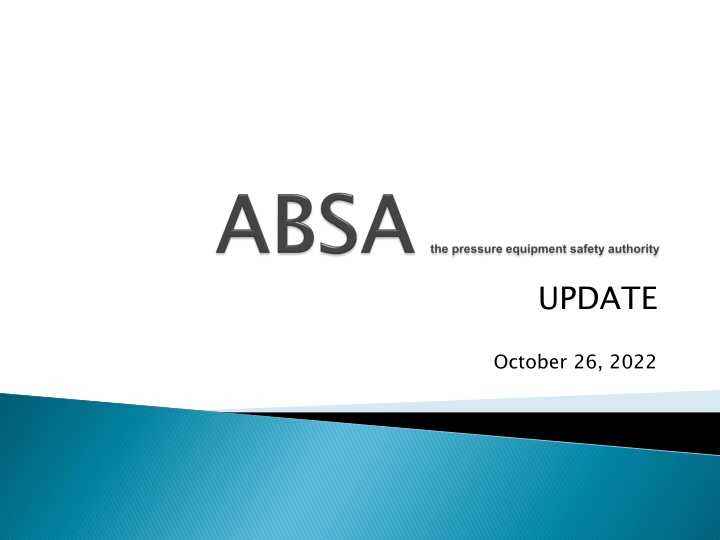
Alberta Power Engineers Regulation Updates October 2022
Stay updated with the latest Alberta Power Engineers Regulation changes including plant registry updates, audits findings, and more for October 2022. Learn about reduced supervision requirements, electronic log books, certification candidates, and thermal liquid heating systems guidelines.
Download Presentation

Please find below an Image/Link to download the presentation.
The content on the website is provided AS IS for your information and personal use only. It may not be sold, licensed, or shared on other websites without obtaining consent from the author. If you encounter any issues during the download, it is possible that the publisher has removed the file from their server.
You are allowed to download the files provided on this website for personal or commercial use, subject to the condition that they are used lawfully. All files are the property of their respective owners.
The content on the website is provided AS IS for your information and personal use only. It may not be sold, licensed, or shared on other websites without obtaining consent from the author.
E N D
Presentation Transcript
UPDATE October 26, 2022
- Information bulletins - Plant registry update - Audits findings - SOPEEC update
IB-22-004 INTERPRETATION Requirements for Reduced Supervision in accordance with the Power Engineers Regulation (AR(85/2003) AB-528 Requirements for Reduced Supervision of Power Plants, Thermal Liquid Heating Systems, and Heating Plants, Edition 3, Revision 1, issued on February 18, 2020, with minor revisions.
IB21-015 Electronic Log Book Power Engineers Regulation Clarification for the requirements for the use of an Electronic Log Book . Replaced IB14-008
IB21-014 Power Engineer Certification Candidates with Qualifying Experience from Outside of Alberta A candidate for certification must hold a valid certificate in the jurisdiction in which they are working in order to obtain operating time in that jurisdiction. Replaces IB13-007
IB-21-012 INTERPRETATION Requirements for Thermal Liquid Heating Systems AB-537: Thermal Liquid Heating System (TLHS) Requirements, Edition 1, Revision 1, Revised on October 29, 2021 and provides compliance guidance and specifies requirements that must be met for thermal liquid heating systems operating in Alberta. No technical changes
IB20-001 IB20 Amendment to Pressure Equipment Exemption Order (AR56/2006) IB20- -001 001 Thermal Liquid Heating Systems Partial Exemption Power Engineers Regulation (AR84/2003) does not apply to a thermal liquid heating system in a chemical processing plant, natural gas processing plant or oil refinery
IB20-003 IB20-003 Updated documents to reflect partial exemptions for Thermal Liquid Heating systems. AB-529: Pressure Equipment Exemption Order User Guide, Revision 4, AB-508: Safety Codes Act Flowchart, 2020-02 AB-516: Pressure Equipment Safety Regulation User Guide, Edition 3, Revision 0
IB21-001 Reference Syllabus for Welding Examiner and Welding Examiner in Training Revised Syllabus
IB18-004-R1IB18-004-R1 UPDATE This Information Bulletin provides compliance guidance respecting the owner s duty to report unsafe conditions, accidents and fires pursuant to Section 35 of the Pressure Equipment Safety Regulation which states: 35(1) The owner of pressure equipment must forthwith report to the Administrator under section 59 of the Act any unsafe condition, accident or fire that occurs with respect to that pressure equipment.
Summary of Unsafe Condition, Accident & Fire Reports Summary of Unsafe Condition, Accident & Fire Reports
VA21-008 Variance to provide options for expired Building Operator A, Building Operator B, and Fireman s Certificate of Competency Allows for an avenue to upgrade the above certificates of competency if expired. Requires completion of a course satisfactory to the Administrator. Replaces VA-15-006
11,065 plants registered in database. Total Power Plants in service 2020 1stclass 124 2ndclass 33 3rdclass 124 4thclass 541 5thclass 553 Attended 645 Note: there are approximately 6950 operating plants in-service at this time.
On track to meet our target of 50 plant registry validations by the end of October. On-site validations recommenced in 2022. Some remote validations due to restrictions Your assistance with this undertaking is greatly appreciated.
We asked one of our senior inspectors who is heavily involved in Owner-User audits what the big hitters are from an operations point-of-view. The following are his highlight's.
Purchasing Receiving of goods and services at the field level. Often field operators perform material purchasing and receiving. We typically find the following Inadequate material specification Improper receiving inspections It is imperative that operators use an approved vendor list for such activities. Additionally they must be trained and competent for such activities.
Car Seal programs (Seal or Lock) While operations usually looks after this activity the following are often overlooked. Support by design List controlled, and approved as being complete Traceable to design by way of P&IDs. SCO approval prior to implementation Consideration of valves in the path of critical shutdowns/low level trips, etc.
Pre Start-up Safety Reviews (PSSR) A program must be in place for both newly installed equipment and equipment ready to return to service (turnarounds) This is usually based around a permit system (IE: permits returned the system can be energized) Process should incorporate the following: Are inspections/repairs completed Are safety critical equipment calibrated Are PSV s serviced and installed and visually inspected Are ABSA certificate of inspections available (MDS s, AB- 83 s, etc.) Ensure Operations has a PSSR process!!!
PSV removal and installation Most programs utilize a two tag approach The valve and the location to which it belongs are tagged and the valve is sent out for service. When returned the operator/contractor will reinstall the valve by matching the tags. The issue often found is that the valve data plate is recorded going and returning but typically not verified to design IE: set pressure, capacity orifice, etc.
Training and Competency The responsible individual must have a training and competency profile including all activities and be deemed competent to perform. Often training and competency verification is performed but not records are available.
Operator competency reassessments Rarely is a reassessment conducted. An organization must have a process for this at a defined interval. This ensures complacency issues do not arise and provides an opportunity for continuous improvement by way of procedure refinement, etc.
Log Books Whether it s a Power Engineers regulatory requirement or a site log, the issue is with content. Content is often minimal or none existent Missing dates are a frequent issue Coaching is required to inform operators that more information is often better. Ensure there are entries for all days to ensure that the necessary checks are being performed.
Accidents/unsafe conditions Solid compliance with IB18-004 is often misunderstood Owners must ensure reporting is completed in accordance with the bulletin If in doubt the owner should contact there respective Safety Codes Officer to determine if an incident is reportable or not
AB-523 program While the document is a guideline if it is included in the scope of work and identified on the AB-512a then it is a process approved by the auditor and is then mandatory. Even if this is in an owners program scope hydrotesting is rarely performed. While this is ok a documented risk assessment is not required. Additionally the in-service testing should be completed and documented. There is a big training and competency component often overlooked. Records pertaining to this program are often hit and miss.
Overdue inspections For various reasons equipment often goes overdue ABSA has begun issuing major findings when this becomes higher than reasonable. Operators in charge of this equipment must be aware that if they have care and control and the equipment is not current then they must get involved and influence change so that they are operating equipment with a valid integrity assessment.
Management of Change (MOC) Most Owner Users have a program but it can fall short on identifying (and completing) updates resulting from a change. For example Updating P&IDs Updating car seal lists Addressing operating procedures/training
Standardization of Power Engineering Examination Committee Consists of all Canadian Jurisdictions Reports to the Association of Chief Inspectors Works with industry representatives and training providers both jurisdictionally and nationally (IPECC*) Creates all examination delivered for power engineering across Canada. *Interprovincial Power Engineering Cirriculum Committee
2A3 examinations goes multiple choice. Effective January 1, 2023 the 2A3 examination will be delivered in a multiple choice format. 2B1, 2B2, & 2B3 examinations are multiple choice. Effective January 1, 2022, 2021, & 2020 respectively, the 2B1, 2B2, & 2B3 examinations are now delivered in a multiple choice format.
Effective January 1, 2023 the 3rd, 4th, and 5th class examination will be 100 multiple choice questions Effective January 1, 2023 the 3rd, 4th, and 5th class examinations will have a 3 hour time limit.


